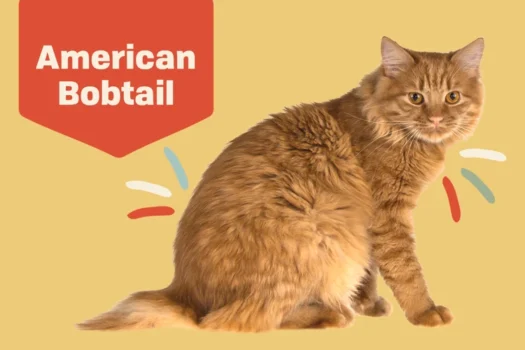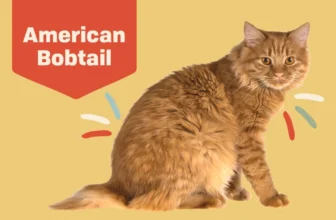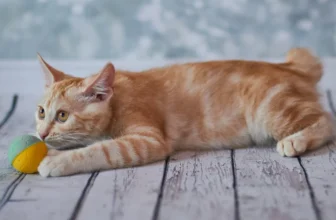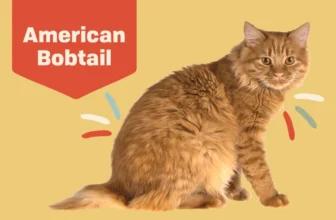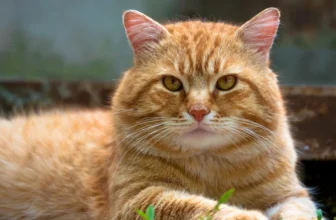As cat lovers, we are always fascinated by the different physical characteristics that make each breed unique. One such breed is the American Bobtail cat. These cats are known for their distinctive coats that come in a variety of patterns and colors, as well as their short, bobbed tails. The American Bobtail cat breed has been around since the 1960s and has since gained a lot of popularity. In this article, we will dive deeper into the different physical characteristics that make up the American Bobtail cat’s coat, providing an overview of its appearance, texture, and color. We will also discuss how to care for their standout coats so that they remain healthy and beautiful. So, let’s get started and explore the unique features of the American Bobtail cat’s coat!
Overall Appearance of American Bobtail Cats’ Coats
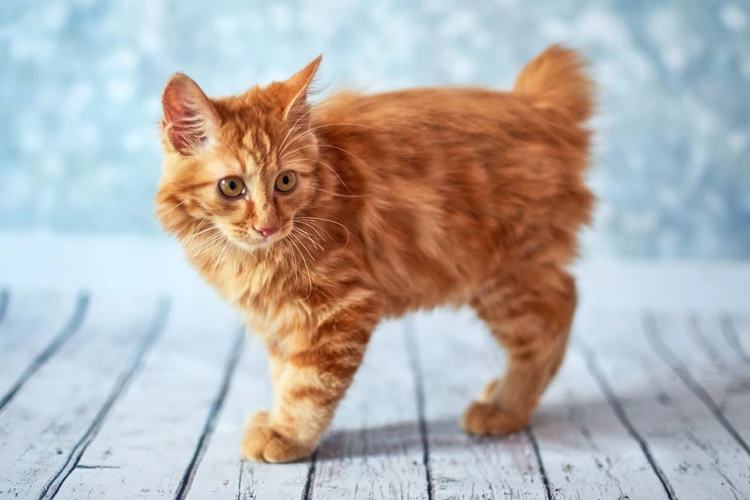
As soon as you see an American Bobtail cat, their unique appearance becomes evident. Their coats are one of their most defining features and can vary in colour and pattern between cats. Let’s take a closer look at the distinctive physical characteristics of American Bobtail cats’ coats. Observing their fur, we can identify features that make them look wild and natural. Lynx tips, ruffed necks and bellies are all eye-catching features that add to their overall appeal. American Bobtail cats’ coats also come in a wide range of colours and patterns, including tabby, which we’ll explore further in tabby bobtail cats, a perfect reflection of their breed’s diversity.
Short but Thick Coats
American Bobtail cats are known for their distinctive physical characteristics, and their coat is no exception. Their coat is short but thick, providing them with ample protection against the elements. This breed is designed to thrive in outdoor environments, and their coat is an important part of their survival kit.
Though the Bobtail’s coat is short, it is still quite thick to the touch. This is because the breed originates from the Northern United States and is built to withstand harsh Winter conditions. Their thick coat is a natural adaptation that helps them stay warm in cold weather.
In addition to providing warmth and protection, the American Bobtail’s coat is also incredibly soft to the touch. When you stroke the coat of an American Bobtail, you’ll notice how plush and comfortable it feels against your skin. These cats love nothing more than snuggling up in a cozy blanket and taking a long nap.
One of the benefits of their short but thick coats is the reduced shedding. This attribute makes them perfect for indoor living, as they won’t leave a lot of hair around the house compared to a breed with a longer or thicker coat. However, regular grooming is still an essential aspect of maintaining a healthy coat.
The American Bobtail breed has a short, thick coat designed to protect them from the elements and keep them warm in all weather conditions. Whether you have a short haired or longer haired bobtail cat, it is important to brush them regularly to keep their coat healthy and shiny. For more information on the different colors and patterns of American Bobtail cat coats, please visit our article on ‘American Bobtail Cat Coat Colors.’
Natural Wild Appearance
American Bobtail cats’ coats have a natural wild appearance that sets them apart from other domesticated cats. One of the distinctive features of their coats is the short but thick fur that has a coarse texture. It gives them a rugged look that’s reminiscent of their wild ancestors.
Their fur also has lynx tips, which means that the tips of their fur strands are dark, contrasting with the lighter base. This unique characteristic gives the fur a multi-hued appearance that adds to the cat’s overall wild look. Additionally, American Bobtail cats’ coats have ruffed necks and bellies, adding to their already natural look.
As for colors and patterns, American Bobtail cats possess a unique variety of coat colors and patterns. They can come in solid colors as well as various shades of tabby. For example, they can have spots, stripes and even rosettes. The colors range from subdued to vibrant and eye-catching, making them a beautiful addition to any household. Genetic variations also play a role in their coat colors, which can be further explored in our article on genetics and coat colors of American Bobtail cats.
Here is a table showcasing the variety of colors and patterns the American Bobtail cat’s coat can come in:
| Colors | Patterns |
| Solid white | Spotted tabby |
| Solid black | Mackerel tabby |
| Solid red | Classic tabby |
| Solid cream | Patched tabby |
| Blue | Bi-Color |
| Fawn | Tri-Color |
To keep your American Bobtail cat’s coat looking its best, regular grooming is essential, which can be explored further in our article on Bobtail cat coat care.
Lynx Tips
American Bobtail cats’ coats have a distinctive feature known as “Lynx Tips.” These tips are most commonly found on the tips of the fur on the ears. The fur at the ear tips is typically black and stands out against the other colors of the coat, creating a rustic, wild appearance that is befitting of the breed’s origins.
Lynx tips are not limited to the ears, however. They can also be found on other parts of the coat, such as the tail or legs. These tips are typically black or dark brown in color and can create an interesting contrast with the lighter colors of the coat.
The Lynx Tips on American Bobtail cats’ coats are a feature that sets them apart from other felines. They contribute to their natural, wild appearance and highlight their unique breed traits. To learn more about spotting American Bobtail coats, check out our article on spotting American Bobtail coats.
Below is a table summarizing the key features of the Lynx Tips on American Bobtail cats’ coats:
| Key Feature | Description |
|---|---|
| Ears | Fur at the ear tips is typically black |
| Tail | Lynx tips can also be found on the tail |
| Legs | Lynx tips can also be found on the legs |
| Color | Lynx tips are typically black or dark brown |
Ruffed Necks and Bellies
The ruffed neck and belly are distinctive physical characteristics of American Bobtail cats. These areas of the cat’s coat have longer hair than the rest of the body, creating a ruffled effect. This feature adds to the wild and natural appearance of the breed.
Benefits of Ruffed Necks and Bellies
The ruff around the neck and the belly of an American Bobtail are not only visually appealing but also serve practical purposes. The longer fur provides extra protection and warmth during colder weather, especially for cats that spend time outdoors.
Notable Appearance
The ruff around the neck and the belly of an American Bobtail can vary in length and thickness, depending on the individual cat. Some cats have more pronounced ruffs, while others may have a subtler ruffled appearance that requires closer observation.
Distinctive Markings
In some American Bobtail cats, the ruffs on the neck and belly may also have unique markings such as spots, stripes or rosettes. These patterns add to the distinctiveness of the breed.
Caring for Ruffed Necks and Bellies
Regular grooming is necessary to maintain the condition of the longer fur around the neck and belly. Combing or brushing every few days will help to prevent matting and tangling. Special care should be taken around these areas, as the fur can be more sensitive and prone to irritation.
The ruffed neck and belly of an American Bobtail is an eye-catching feature that adds to their unique appearance. With proper care, this distinctive characteristic can be enjoyed for many years as a beautiful and functional part of their coat.
Variety of Colors and Patterns
The American Bobtail cat breed is known for its unique coat, which comes in a variety of colors and patterns. From solid colors to intricate patterns, the American Bobtail cat’s coat truly stands out. Here are some of the most common colors and patterns found in American Bobtail cats:
- Tabby: This is one of the most common coat patterns in American Bobtail cats. The tabby pattern is characterized by bold, swirling stripes on the cat’s coat that give it a wild and adventurous appearance.
- Black: Black coloration is a popular choice among cat owners, and the American Bobtail cat is no exception. A solid black coat radiates elegance and sophistication, making it a favorite among many cat enthusiasts.
- Calico: Calico is a unique combination of white, black, and orange patches on the cat’s coat. This pattern is quite popular, as it gives the cat a playful and energetic appearance that cat lovers find difficult to resist.
- White: A solid white American Bobtail cat is a sight to behold. This color is quite rare and adds a touch of purity and innocence to the cat’s overall appearance.
- Tortoiseshell: The tortoiseshell pattern is a combination of black, white, and orange spots on the cat’s coat. This pattern is known for its bold and vibrant appearance and is a favorite among cat owners who love to make a statement.
- Blue: Blue American Bobtail cats have a unique greyish-blue coat that radiates elegance and grace. This color is quite rare and adds a touch of sophistication to the cat’s overall appearance.
- Red: A solid red coat is a rare sight among American Bobtail cats. This color radiates passion and energy, making it a popular choice among cat owners who love an active and playful companion.
These are just a few examples of the many colors and patterns found in American Bobtail cats. Whether you prefer solid colors or intricate patterns, this breed has a coat that is sure to capture your attention. So if you’re looking for a feline companion with a unique and distinctive coat, the American Bobtail cat may be just what you’re looking for.
The Big Picture: Tail
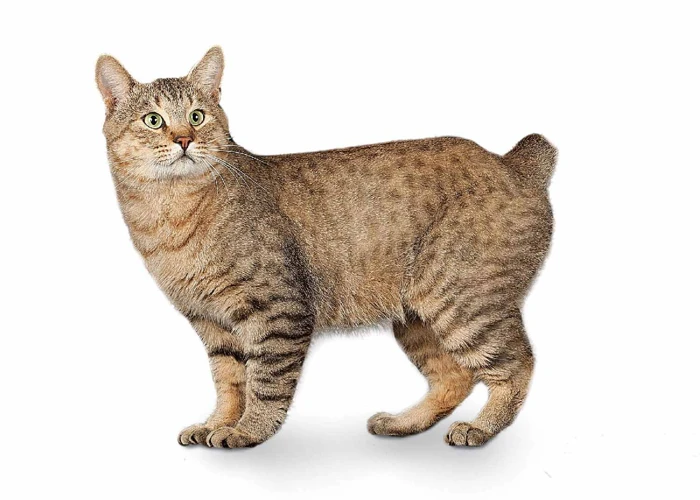
One of the most distinctive and intriguing features of the American Bobtail cat breed is its unique, naturally occurring tail. As you observe these majestic felines, your eyes will inevitably be drawn to their tails – short, stubby, and yet undeniably powerful. The tail of the American Bobtail is a true reflection of the breed’s wild and rugged origins, and in this section of the article, we will dive deep into this fascinating appendage, exploring everything from its appearance to its functionality. Get ready to discover the secrets behind the American Bobtail’s tail!
Naturally Occurring Short Tails
The American Bobtail is well-known for its distinctive short tail, which is naturally occurring and often described as “bobbed.” Unlike some other cat breeds with short tails, the American Bobtail is not a result of selective breeding, but rather a natural genetic mutation that occurred many years ago. This mutation causes the vertebrae in the tail to be short and sometimes even fused together.
What makes this feature so unique?
The short tail of the American Bobtail is only 1/3 the length of a typical domestic cat’s tail, and often appears as though it has been “broken” or “cropped”. However, this is simply due to the natural mutation that causes shorter vertebrae. This breed’s tail also has thick and dense fur which makes it look even more distinct. The American Bobtail’s tail is highly expressive, as it can indicate excitement, contentment, or even aggression.
How does this mutation benefit the cat?
While it is not entirely clear why this genetic mutation occurred, it is evident that it hasn’t negatively impacted the cat’s life. American Bobtails are highly adaptive and agile felines, and their shorter tails do not hinder their movements or abilities. It is also believed that the shorter tail may provide increased balance and agility, making the American Bobtail highly skilled at jumping and climbing.
How can you identify a “purebred” American Bobtail?
To be considered a true American Bobtail, the cat must have a naturally occurring short tail. This feature is so important that some cat shows will disqualify any American Bobtail that does not have a bobbed tail. However, it’s important to note that not all individuals within the breed will have identical tails. The length and shape of the tail can vary from cat to cat, but what is important is that the tail is naturally short and does not cause the cat any discomfort.
If you are looking to purchase an American Bobtail, make sure to check that the tail is short, sturdy and healthy. Additionally, make sure to purchase from a reputable breeder who can confirm that the cat is a true American Bobtail with the unique short tail feature.
Tails are Thick at Base and Tapered at End
One of the most remarkable physical features of American Bobtail cats is their tails. Unlike many other cat breeds, American Bobtails have tails that are thick at the base and tapered at the end. This distinctive tail shape is one of the reasons these cats are easily identifiable.
The thick base of American Bobtail cats’ tails is due to its prominent musculature. These muscles allow for greater control and agility, giving the cat the ability to quickly change direction or jump with ease. In contrast, the tapered end of the tail is covered in a soft and fluffy fur. This combination of muscles and fur gives the tail a unique texture that is enjoyable to touch and stroke.
Another good thing about these cats is that their tails come in many different lengths and shapes. Some American Bobtails have shorter tails, while others have tails that are longer and more slender. The variety in tail length and thickness adds to their beauty and uniqueness.
It is interesting to note that not all American Bobtails have tails with the same degree of thickness. Some have thinner tails at the base, while others have exceptionally thick tails. The thickness of the tail is sometimes determined by genetics, but it can also be influenced by environmental factors such as diet and grooming.
American Bobtail cats have tails that are thick at the base and tapered at the end. These tails are prominently muscled and covered in a soft, fluffy fur. American Bobtails have tails that come in many different lengths and thicknesses, adding to the cat’s unique appearance. The tail is an important characteristic of this breed and adds to their overall beauty and charm.
Tails Come in a Variety of Lengths and Shapes
American Bobtail cats are famous for their distinctive tails, which come in a variety of lengths and shapes, making them unique and easily recognizable. Let’s take a closer look at the different lengths and shapes of American Bobtail cat tails in the following table:
| Types of American Bobtail Tails | Description |
|---|---|
| Bobtail | The classic short tail of the American Bobtail, which ranges from 2-4 inches in length. |
| Rumpy | The rarest type of American Bobtail tail, where there is almost no tail visible, and in some cases none at all. The taillessness is due to a genetic mutation. |
| Stubby | The tail is only slightly longer than the Rumpy American Bobtail and is often curved or kinked. |
| Longy | The longest type of American Bobtail tail, measuring up to 5 or 6 inches in length. |
| Slinky | The tail is flexible and can move like a snake, making it unique among other cat breeds. |
It is important to note that different American Bobtail tail lengths and shapes don’t affect their ability to play, climb or jump, nor do they affect their overall health. These unique tail characteristics make American Bobtail cats stand out and have made them a popular breed among cat enthusiasts.
Coat in Detail: Texture and Color
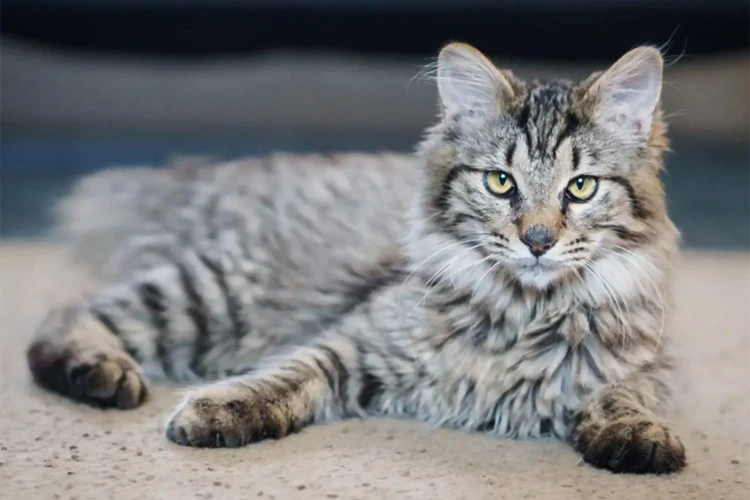
As we delve deeper into the distinct physical characteristics of American Bobtail cats, it’s essential to take a closer look at their coat’s textures and colors. This stunning breed’s coat is a unique feature, with a short, coarse fur coat that comes in a variety of colors and patterns. American Bobtails’ gorgeous markings make them stand out from other breeds, so let’s explore and appreciate the beauty of their coats.
The Short, Coarse Fur Coat
The American Bobtail cat breed is known for its distinctive coat, which is short and coarse to the touch. The texture of their fur makes them unique and easily recognizable among other breeds.
Some key characteristics of the American Bobtail’s short, coarse fur coat include:
- The fur is dense and plush to the touch, providing a very soft and comfortable feeling when petting the cat.
- The hair is straight but not too fine, which adds to the natural wild appearance of the breed.
- The coat usually has a natural shine, which is due to the dense fur and natural oils produced by the cat’s skin.
- The fur can vary in thickness from one area of the body to another. For instance, the hair on the tail and belly is usually thicker than on other parts of the body.
- While they may have a rougher texture than some breeds, American Bobtails’ coats are still very manageable and require only minimal brushing to maintain their healthy appearance.
In general, the American Bobtail’s fur coat is very resilient and can withstand a fair amount of wear and tear. It’s important to note, however, that despite the low maintenance requirements, regular grooming is still essential for maintaining healthy and happy cats.
The American Bobtail’s Spots, Stripes and Rosettes
The American Bobtail’s coat is not only thick and wild in appearance, but it also boasts a variety of distinctive patterns. Their coat can be adorned with spots, stripes, and rosettes that add to their unique appearance. These patterns can be seen in a range of colors, including brown, black, blue, cream, and red.
Spots: Some American Bobtails have spots on their coat, which can come in different shapes and sizes. The spots can be circular or oval and can be scattered throughout the cat’s coat. These spots can be in a solid color or have a darker outline.
Stripes: Similar to their wild cat ancestors, some American Bobtails have stripes on their coat. The stripes can be thick or thin, and they can run horizontally or vertically along the cat’s body. These stripes can give the cat a more fierce and wild appearance.
Rosettes: Rosettes are unique patterns that are often found in wild cats, such as leopards and jaguars. Some American Bobtails can have rosettes on their coat, which resemble dark rings or spots with a lighter color in the center. These patterns are often found on the cat’s back and sides.
The American Bobtail’s spots, stripes, and rosettes are not only visually appealing, but they also serve as camouflage in the wild, helping them blend in with their surroundings. The unique patterns make each American Bobtail cat one-of-a-kind, and it’s fascinating to observe the different variations of their coat.
It’s also important to note that the patterns and colors of an American Bobtail’s coat can change over time. Kittens may have a different appearance than adult cats, and their coat can even change with each season. It’s crucial to pay attention to any changes in their coat’s appearance and take proper care of it.
Eye-Catching Colors and Patterns
The American Bobtail cat breed is well known for their distinctive physical characteristics, particularly the unique color and pattern of their fur. American Bobtail cats come in a variety of colors and patterns, from solid colors to complex patterns such as spots, stripes, and rosettes.
One of the most popular colored American Bobtail cats is the red tabby. A red tabby American Bobtail typically has a bright reddish-orange coat color with bold black stripes. Another popular color is the silver tabby which has a light silver coat with dark grey stripes. The coat of the American Bobtail can also be bi-color or tri-color, with cats displaying varying degrees of white fur on their chest, legs, and face.
In addition to solid colors and tabby patterns, American Bobtail cats can also have various other patterns such as tortoiseshell, calico, and pointed. Tortoiseshell American Bobtails have coats that are patchy with different shades of red, black, and brown. Calico patterns in American Bobtails are characterized by their white fur, with patches of red and black scattered throughout the coat. Pointed American Bobtail cats, on the other hand, have darker colors on their face, tail, and legs, with lighter colored fur on their body and chest.
Their unique coloring and distinctive patterns make American Bobtail cats stand out in a crowd of cats. Not only do they have physical characteristics that are visually stunning, but they also have personalities that are just as unique and captivating. If you’re looking for a feline companion with a striking appearance and playful spirit, the American Bobtail may be the perfect choice for you.
Below is a table with examples of popular American Bobtail coat colors and patterns:
| Coat Color/Pattern | Description |
| Red Tabby | Bright reddish-orange coat color with bold black stripes |
| Silver Tabby | Light silver coat color with dark grey stripes |
| Tortoiseshell | Coat is patchy with different shades of red, black, and brown |
| Calico | White fur with patches of red and black scattered throughout the coat |
| Pointed | Darker colors on face, tail, and legs, with lighter colored fur on body and chest |
Caring for American Bobtail Cats’ Coats
As a proud owner of an American Bobtail, one of the essential aspects of keeping your feline friend healthy is taking care of their coat. Regular grooming is key in keeping their distinctive coat looking healthy and shiny. In this section, we will discuss the various steps you need to take to take care of your American Bobtail’s coat, including regular grooming sessions, bathing techniques, and keeping their fur clean and healthy. So, let’s get started and learn how to provide your American Bobtail with the care it deserves.
Regular Grooming Sessions
Regular grooming sessions are essential in maintaining an American Bobtail cat’s coat. Not only does grooming keep them looking and feeling their best, but it also promotes a healthy coat and skin. Here is a breakdown of the key components of regular grooming sessions for American Bobtail cats:
| Grooming Component | Description |
|---|---|
| Brushing | Regular brushing helps to remove any loose fur, dirt, and debris from your American Bobtail’s coat. This prevents mats and tangles from forming, which can be uncomfortable and even painful for your cat. |
| Nail trimming | Trimming your American Bobtail’s nails regularly can prevent painful overgrowth, splitting, and even ingrown nails. It also helps to protect your furniture and prevent any damage caused by scratching. |
| Cleaning ears and eyes | Checking your American Bobtail’s ears and eyes regularly and cleaning them when necessary can help prevent infections and other issues. Use a gentle, vet-approved solution to clean the ears and a damp cloth to clean around the eyes. |
| Bathing | American Bobtail cats do not typically require frequent baths, but if you notice that their coat is particularly dirty or oily, a bath may help. Use a cat-specific shampoo and be sure to rinse thoroughly to prevent any irritation. |
It’s important to establish a regular grooming routine with your American Bobtail cat from a young age to help them become comfortable and cooperative during grooming sessions. Grooming is not only beneficial for your cat’s physical health but also for bonding and building trust between you and your feline companion.
Bathing your American Bobtail
Bathing your American Bobtail is an important part of maintaining their coat’s health and cleanliness. However, unlike some other cat breeds, American Bobtails do not require frequent bathing. In fact, bathing them too often can strip their coat of its natural oils, leading to skin irritation and dryness.
When should you bathe your American Bobtail?
It is recommended to bathe your American Bobtail no more than once every 6-8 weeks, unless they get into something particularly dirty or smelly. Additionally, if your cat has a medical condition that requires more frequent bathing, consult with your veterinarian for guidance.
How to prepare for a cat bath?
Before starting the bathing process, it’s important to gather all necessary supplies:
| Supplies | Description |
|---|---|
| Shampoo | Choose a cat-specific shampoo that is gentle and fragrance-free. |
| Bucket or Cup | For rinsing your cat’s fur. |
| Towels | Have several towels on hand for drying your cat. |
| Brush | Brush your cat’s coat before bathing to remove any loose fur and tangles. |
| Rubber Mat | To prevent your cat from slipping in the tub or sink. |
How to bathe your American Bobtail?
Here’s a step-by-step guide on how to bathe your American Bobtail:
- Fill the tub or sink with warm water that reaches your cat’s belly.
- Gently place your cat in the water, using one hand to steady them.
- Wet your cat’s fur with a cup or bucket, being careful not to get any water in their ears.
- Apply a small amount of shampoo to your cat’s fur and massage it in, starting at the neck and working your way down to the tail.
- Rinse your cat’s fur thoroughly with warm water, starting from the neck and working your way down.
- Use a towel to gently pat your cat dry, taking care not to rub their fur too harshly.
- Let your cat air-dry in a warm, draft-free area.
Avoiding bath time stress
Many cats do not enjoy being bathed, so it’s important to make the experience as stress-free as possible. Speak softly to your cat and provide treats or toys to distract them during the process. If your cat becomes too stressed, stop the bath and try again another day.
With regular grooming and occasional bathing, your American Bobtail’s coat will remain healthy and shiny.
Keeping your American Bobtail’s Coat Clean and Healthy
As a loving and responsible pet owner, it’s essential to keep your American Bobtail’s coat clean and healthy. Neglecting your cat’s coat can lead to matting, skin irritations, and even health problems. Here are some steps you can take to ensure your American Bobtail’s coat stays in top condition:
| Step 1: | Brush your cat regularly to prevent matting and remove loose hair. Use a soft, bristled brush to gently comb through their coat in the direction of hair growth. Pay particular attention to the areas where matting is common, such as the belly and behind the ears. |
| Step 2: | Trim your cat’s nails regularly to prevent them from getting caught in their coat and causing discomfort. Also, make sure to trim the hair around their paw pads to prevent matting and dirt buildup. |
| Step 3: | Wipe your cat’s eyes regularly with a damp cloth to remove any discharge or debris. This will prevent eye infections and keep their coat clean around the eye area. |
| Step 4: | Bathe your cat occasionally using a cat-specific shampoo. Make sure to rinse thoroughly to avoid any residue buildup that can lead to skin irritations. However, avoid bathing your cat frequently as it can strip their skin of natural oils and cause dryness. |
| Step 5: | Check your cat for fleas and ticks regularly. Use a flea comb to remove any fleas or ticks from their coat. Also, make sure to use a flea and tick preventative as recommended by your veterinarian. |
By following these steps, you can ensure your American Bobtail’s coat stays in top condition, keeping them healthy and happy. Remember to always consult your veterinarian if you have any concerns about your cat’s coat or overall health.
Important Note on Seasonal Shedding
American Bobtail cats experience seasonal shedding as part of their natural body processes. As the seasons change, these cats will start to shed their winter coats, which involves the shedding of hair in massive amounts. This shedding is completely normal and should not be a cause for concern for pet owners.
However, it is important to note that regular grooming can help reduce the amount of shed hair in your home. Brushing your American Bobtail’s coat regularly (at least 2-3 times a week) can help remove any loose fur before it spreads around your home. Additionally, during the shedding season, it is recommended to increase the frequency of brushing to keep the shedding under control.
While shedding is a natural phenomenon, excessive shedding can be a sign of underlying health issues. If you notice that your American Bobtail is shedding excessively or has patches of missing hair, you should take them to a veterinary professional for a check-up.
You can help reduce shedding by ensuring that your American Bobtail receives a balanced, nutrient-rich diet. Providing them with high-quality food that meets their nutritional needs can help maintain a healthy coat.
Seasonal shedding is typical for American Bobtail cats, but it can be managed with regular grooming and feeding a balanced diet. However, if shedding is excessive or accompanied by other symptoms, it is essential to seek medical advice to ensure your cat’s overall health and well-being.
Conclusion
As we conclude our overview of the distinctive physical characteristics of American Bobtail cats’ coats, it is clear that they possess a unique and wild appearance that sets them apart from other domestic cats. With their short but thick coats, ruffed necks and bellies, lynx tips, and a variety of colors and patterns, the American Bobtail’s coat is indeed a sight to behold.
But it’s not just their coats that make them special. The American Bobtail’s tails are also a noteworthy feature; with naturally occurring short tails that are thick at the base and tapered at the end, they come in a variety of lengths and shapes that are truly fascinating.
And let’s not forget about the texture and color of the American Bobtail’s coat. With its short, coarse fur, spots, stripes, and rosettes, and eye-catching colors and patterns, their coats are a true reflection of their wild and adventurous nature.
Caring for the American Bobtail’s coat is also important to maintain its health and beauty. Regular grooming sessions, bathing, and keeping their coats clean are just a few essential steps that will keep their fur looking and feeling great. But be prepared for seasonal shedding in spring and fall, as the American Bobtail’s thick coat adapts to the changing weather.
In conclusion, the American Bobtail cat’s coat is an integral part of its unique and wild appearance, setting them apart from other domestic cats. Their short but thick coats, ruffed necks and bellies, lynx tips, and variety of colors and patterns, combined with their fascinating tails, make them a truly remarkable and captivating breed. Caring for their coats is an essential aspect of keeping them healthy and happy, and with proper care, their coats will continue to turn heads for years to come.
Frequently Asked Questions
What is the origin of American Bobtail cats?
American Bobtail cats are a breed that originates in the United States, with their early beginnings traced to feral cats found roaming in the southwestern part of the country.
Do American Bobtail cats come in only one color and pattern?
No, American Bobtail cats come in a variety of colors and patterns, including solid colors, bi-color, tri-color, smoke, shaded, and more.
How long does an American Bobtail cat’s coat typically grow?
American Bobtail cats have short, thick coats that grow to about 2 inches long at the most.
Do American Bobtail cats have any distinct markings on their coat?
American Bobtail cats are known for their distinctive lynx tips on their ears, and some cats may also have spots, stripes, or rosettes on their coat.
Do American Bobtail cats require a lot of grooming?
While American Bobtail cats have short coats, they still require regular grooming to maintain their healthy and shiny appearance. Regular brushing and occasional baths are recommended.
Do American Bobtail cats shed a lot?
Like most cats, American Bobtail cats experience seasonal shedding. You can help minimize shedding by grooming your cat regularly and ensuring they have a healthy diet.
Are American Bobtail cats hypoallergenic?
While no cat breed is completely hypoallergenic, some people with allergies may find that they are less affected by American Bobtail cats due to their short coats.
What is the temperament of American Bobtail cats?
American Bobtail cats are known for being intelligent, affectionate, and playful. They are also social and enjoy spending time with their family members.
Are American Bobtail cats good with children?
Yes, American Bobtail cats are generally good with children, as they are playful and curious. However, it is important to supervise any interactions between children and cats.
Do American Bobtail cats make good indoor pets or do they need outside time?
American Bobtail cats can adapt to living indoors, but like all cats, they need mental and physical stimulation. Providing them with toys and opportunities to play and explore will keep them happy and healthy.

